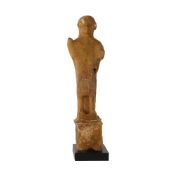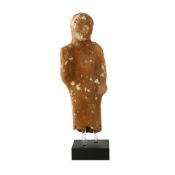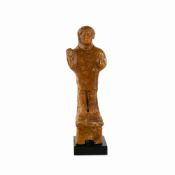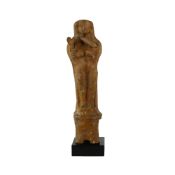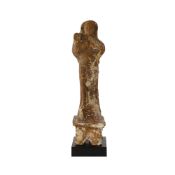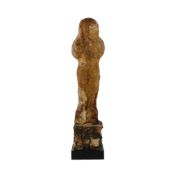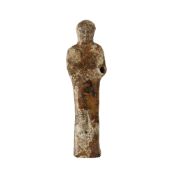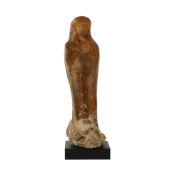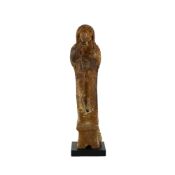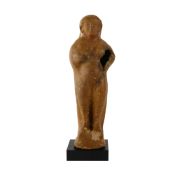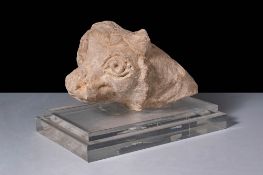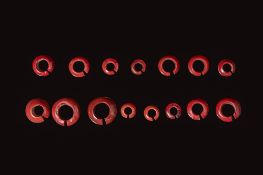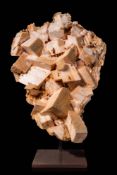Ca. 6th century BC A terracotta sculpture representing a typical Phoenician boat, reflecting the importance of seafaring for this civilisation. Th...
*
Sortieren nach:
- Nur Lose mit Abbildungen,
- Auktionshaus
- Liste
- Galerie
-
909 Los(e)/Seite
Ca. 6th century BC A terracotta sculpture depicting a man dressed in a classical tunic and with a hairstyle of classical form. The piece belongs t...
Ca. 6th - 4th century BC A sculpture of a man dressed in a classical tunic with vertical folds and a classical hairstyle. This terracotta belongs ...
Ca. 6th century BC A terracotta sculpture representing a female deity, most likely assimilated to the goddess Astarte, protector of the household ...
Ca. 6th - 4th century BC A terracotta sculpture depicting a man dressed in a classical tunic and with a hairstyle of classical form. The piece bel...
Ca. 5th - 4th century BC A terracotta sculpture depicting a man dressed in a classical tunic and with a hairstyle of classical form. The piece bel...
Ca. 5th century BC A terracotta sculpture depicting a man dressed in a classical tunic and with a hairstyle of classical form. The piece belongs t...
Ca. 8th - 6th century BC A sculpture of a man dressed in a classical tunic and wearing a classical hairstyle. This terracotta belongs to a group o...
Ca. 8th century BC A sculpture representing a typical Phoenician vessel in terracotta, which denotes the importance of navigation for this civiliz...
Ca. 6th - 4th century BC A sculpture representing a woman playing a musical instrument, possibly a harp. This sculpture forms part of a group of P...
Ca. 5th - 4th century BC A sculpture of a man dressed in a classical tunic and wearing a classical hairstyle. This terracotta belongs to a group o...
Ca. 6th - 5th century BC A sculpture of a female dressed in a classical tunic and wearing a classical hairstyle. This terracotta belongs to a grou...
Ca. 7th - 6th century BC A terracotta sculpture representing a typical Phoenician boat, highlighting the central role of navigation in this civili...
Ca. 6th - 4th century BC A sculpture representing a childbirth scene, with a woman giving birth on a special birthing chair, accompanied by two mi...
PHOENICIAN TERRACOTTA MALE FIGURE IN A MARCHING POSE AND POSSIBLY CARRYING OFFERINGS ON HIS SHOULDER
Ca. 6th - 4th century BCA sculpture of a man, executed in an archaic technique without detailed treatment of the clothing or facial features, and ...
PHOENICIAN TERRACOTTA DRESSED FEMALE FIGURE POSSIBLY PREGNANT IN A POSE OF PRAYER AND PETITION - TL
Ca. 6th - 4th century BC A sculpture representing a woman, possibly a goddess. This sculpture forms part of a group of Phoenician terracottas disc...
Ca. 5th - 4th century BC A terracotta sculpture depicting a man dressed in a classical tunic and with a hairstyle of classical form. The piece bel...
Ca. 5th - 4th century BC A sculpture of a man dressed in a classical tunic and wearing a classical hairstyle. This terracotta belongs to a group o...
Ca. 6th - 4th century BC A terracotta sculpture depicting a male figure wearing a classical-style tunic and bearing a similarly styled coiffure. T...
Ca. 6th - 4th century BC A terracotta sculpture depicting a man dressed in a classical tunic and with a hairstyle of classical form. The piece bel...
Ca. 6th - 4th century BC A terracotta sculpture depicting a male figure dressed in a classical-style tunic and with a similarly styled coiffure. T...
Ca. 6th century BC A sculpture of a man dressed in a classical tunic and wearing a classical hairstyle. This terracotta belongs to a group of Phoe...
Ca. 5th - 4th century BC A terracotta sculpture representing a woman, possibly a goddess. The sculpture forms part of a group of Phoenician terrac...
Ca. 6th - 4th century BC A terracotta sculpture representing a female deity, most likely assimilated to the goddess Astarte, protector of the hous...
Ca. 6th - 4th century BC A terracotta sculpture depicting a female figure dressed in a classical-style tunic and with a similarly styled coiffure....
Ca. 7th - 6th century BC A terracotta sculpture depicting a man dressed in a classical tunic and with a hairstyle of classical form. The sculpture...
PHOENICIAN TERRACOTTA MALE FIGURE WITH A GESTURE OF PRAYER OR BLESSING IN A WALKING POSE - TL TESTED
Ca. 6th - 4th century BCA sculpture of a man, executed in an archaic technique without detailed rendering of the garments or facial features, and ...
Ca. 6th - 5th century BC A sculpture representing a female deity dressed in a tunic that covers her head and body. She holds a baby in her arms. S...
Ca. 8th century BC A sculpture of a man dressed in a classical tunic and wearing a classical hairstyle. This terracotta belongs to a group of Phoe...
Ca. 5th - 4th century BC A terracotta sculpture representing a female deity, most likely assimilated to the goddess Astarte, associated with ferti...
Ca. 4th - 3rd century BC A terracotta sculpture representing a woman dressed in a classical tunic and holding an instrument resembling a tambourin...
Ca. 4th century BC A sculpture of a man standing upright and dressed in a tunic. This terracotta belongs to a group of Phoenician figures discover...
Ca. 6th - 4th century BC A sculpture representing a woman, possibly a goddess. This sculpture forms part of a group of Phoenician terracottas disc...
PHOENICIAN TERRACOTTA FEMALE FIGURE IN A POSE OF PRAYER AND IN THE ACT OF PETITIONING - TL TESTED
Ca. 6th century BC A sculpture representing a female deity, likely assimilated to the goddess Astarte—protector of the family and mother goddess a...
Ca. 5th - 4th century BC A sculpture representing a female deity, most likely assimilated to the goddess Astarte, protector of the household and m...
Ca. 6th century BC A sculpture of a man dressed in a classical tunic and wearing a classical hairstyle. This terracotta belongs to a group of Phoe...
PHOENICIAN TERRACOTTA DRESSED PREGNANT FEMALE FIGURE IN A POSE OF PRAYER AND PETITION - TL TESTED
Ca. 6th - 4th century BC A sculpture representing a woman, possibly a goddess. This sculpture forms part of a group of Phoenician terracottas disc...
Ca. 6th - 4th century BC A sculpture representing a woman, possibly a goddess. This sculpture forms part of a group of Phoenician terracottas disc...
Ca. 6th - 4th century BC A sculpture representing a woman playing a musical instrument, possibly a flute. This sculpture forms part of a group of ...
Ca. 6th - 4th century BC A sculpture representing a funerary scene, showing the deceased lying down covered by a blanket, accompanied by a bowl pl...
Ca. 6th - 4th century BC A terracotta sculpture depicting a man dressed in a classical tunic and with a hairstyle of classical form. The piece bel...
PHOENICIAN TERRACOTTA FEMALE FIGURE POSSIBLY IN A POSE OF PRAYER AND CARRYING AN OFFERING - TL TESTE
Ca. 6th - 4th century BC A sculpture representing a female deity, likely assimilated to the goddess Astarte—protector of the family and mother god...
Ca. 6th - 4th century BC A Phoenician sculpture representing a woman, possibly a goddess. This sculpture forms part of a group of Phoenician terra...
Ca. 6th - 4th century BC A sculpture representing a woman playing a musical instrument, possibly a harp. This sculpture forms part of a group of P...
Ca. 6th - 5th century BC A sculpture representing a female dressed in a classical tunic, with a hairstyle also in the classical style. This sculpt...
Ca. 6th - 4th century BCA sculpture depicting a man dressed in a classical tunic and styled with a similarly classical hairstyle. It is part of a ...
Ca. 6th - 4th century BC A sculpture representing a typical Phoenician vessel in terracotta, which denotes the importance of navigation for this c...
Ca. 5th - 4th century BC A terracotta sculpture depicting a man standing upright, dressed in a classical tunic and raised on a pedestal. The piece...
PHOENICIAN TERRACOTTA SEATED MALE FIGURE WITH BOTH ARMS RAISED IN A POSE OF PROTECTION - TL TESTED
Ca. 6th - 4th century BCA seated figure of a man, dressed in a classical tunic and styled with a similarly classical hairstyle. He is positioned o...
Ca. 6th century BC A terracotta sculpture representing a female deity, most likely assimilated to the goddess Astarte, protector of the household ...
Ca. 6th - 4th century BCA sculptural group representing an adult man in a gesture of prayer, accompanied by a child figure observing him. This ter...
ROMAN GLASS KANTHAROS
Ca. AD 1 - 100.A translucent amber-coloured glass kantharos with a deep, rounded cup tapering towards a narrow stem and a flat, circular foot. Two...
Ca. AD 1 - 200. An iron bezel from a finger ring preserving a concave intaglio engraved with the profile portrait of a noblewoman facing right. H...
Ca. 300 - 100 BC. A large pyramidal semi-precious stone pendant set in a gold mount, adorned with gold pellets arranged in vertical lines. The gol...
Ca. 1550 - 664 BC. A restrung necklace of elongated turquoise-blue faience beads centring on a faceted bicone-shaped gold bead. Reviewed by Simon...
Ca. 1500 - 1300 BC. A sculpted limestone head with large almond-shaped eyes, a broad snout with defined nostrils, and short projecting horns. Mou...
Late Period to Ptolemaic Period, Ca. 664 - 30 BC. A group of 15 penannular rings of varying diameter and thickness, each formed as a circular ban...
Ca. 332 BC - AD 100. A gold ring formed from a single rod of circular-section wire wound into six tight spirals, terminating with a stylised serp...
Trepca, Yugoslavia. A mineral plate with a field of pale peach-coloured dolomite rhombs, accompanied by needle-like quartz crystals. The quartz a...
New Kingdom to Ptolemaic Period, Ca. 1550 - 30 BC. A collection of faience beads in a variety of shapes, including ring-shaped, spherical, cylind...












